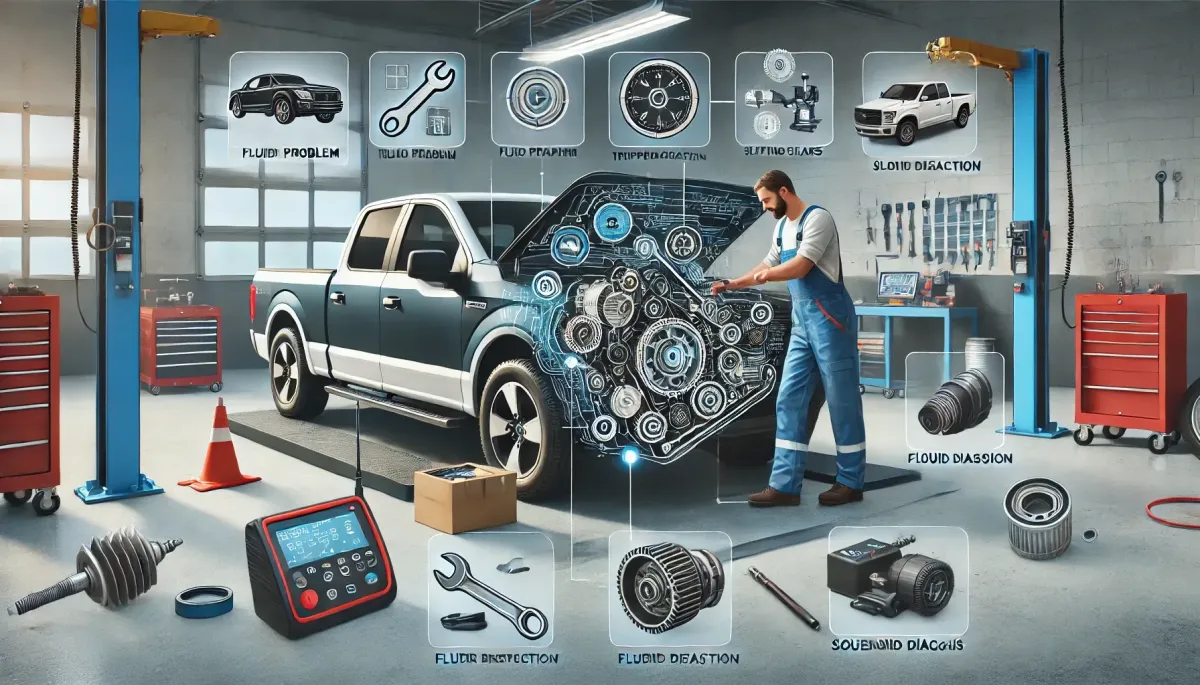
Transmission Troubleshooting: A Comprehensive Guide for Pickup Truck Owners
Transmission Troubleshooting: A Comprehensive Guide for Pickup Truck Owners
Experiencing transmission issues can be one of the most frustrating aspects of owning a pickup truck. However, with the right knowledge and approach, many transmission problems can be diagnosed and fixed without needing a trip to the mechanic. Imagine resolving issues swiftly and confidently, keeping your truck running smoothly and avoiding costly repairs. This chapter provides a comprehensive guide to troubleshooting common transmission problems, empowering you to tackle issues head-on.
Key Points:
Identifying Common Transmission Problems:
Slipping Gears
Delayed or Rough Shifting
Unusual Noises
Transmission Fluid Leaks
Warning Lights on the Dashboard
Diagnostic Tools and Techniques:
Using a Diagnostic Scanner
Inspecting Transmission Fluid
Visual Inspection of Transmission Components
Test Driving for Symptoms
Step-by-Step Troubleshooting Guide:
Checking and Replacing Transmission Fluid
Inspecting and Replacing Filters
Addressing Leaks and Seal Failures
Diagnosing and Replacing Faulty Solenoids
When to Seek Professional Help:
Persistent or Severe Problems
Unclear Diagnostic Results
Major Component Failures
Warranty Considerations
Real-World Examples:
Identifying Problems:
Jake noticed his truck’s transmission slipping when accelerating uphill, prompting a fluid check and replacement.
Sarah heard grinding noises during shifts, leading her to inspect and replace worn-out gears.
Diagnostic Tools:
Tom used a diagnostic scanner to identify error codes indicating a solenoid issue, which he successfully replaced.
Emily’s visual inspection revealed a small fluid leak from a damaged seal, allowing her to address it before it worsened.
Troubleshooting Guide:
Frank followed a step-by-step guide to replace his transmission filter, resolving shifting issues caused by a clogged filter.
Lisa checked and topped off her transmission fluid, eliminating delayed shifting problems.
Seeking Professional Help:
John experienced persistent transmission overheating despite DIY efforts, leading him to a professional mechanic for a thorough diagnosis and repair.
Rachel’s diagnostic scanner revealed multiple error codes, prompting her to seek expert assistance to avoid further damage.
In-Depth Analysis:
Identifying Common Transmission Problems:
Slipping Gears: Often caused by low or degraded transmission fluid, worn clutches, or solenoid issues.
Delayed/Rough Shifting: Can result from low fluid, dirty filters, or failing solenoids.
Unusual Noises: Grinding, whining, or clunking noises may indicate worn gears, bearings, or other internal components.
Fluid Leaks: Identifying the source of leaks, such as seals or gaskets, is crucial to prevent further damage.
Warning Lights: Transmission warning lights indicate various issues, requiring immediate attention and diagnosis.
Diagnostic Tools and Techniques:
Diagnostic Scanner: Retrieves error codes from the truck’s computer, pinpointing specific issues.
Fluid Inspection: Check fluid levels and condition (color, smell) to assess transmission health.
Visual Inspection: Look for visible signs of wear, damage, or leaks around the transmission.
Test Driving: Observe transmission behavior during a test drive to identify symptoms and potential causes.
Step-by-Step Troubleshooting Guide:
Fluid Check/Replacement: Ensure proper fluid levels and replace old or contaminated fluid.
Filter Inspection/Replacement: Replace clogged or dirty filters to improve fluid flow and transmission performance.
Leak Repair: Identify and fix leaks by replacing damaged seals or gaskets.
Solenoid Diagnosis/Replacement: Use a diagnostic scanner to identify faulty solenoids and replace them if necessary.
When to Seek Professional Help:
Persistent Issues: If problems persist despite DIY efforts, consult a professional to avoid further damage.
Unclear Diagnostics: Seek expert assistance if diagnostic results are unclear or indicate multiple issues.
Major Failures: For significant component failures, such as worn-out gears or bearings, professional repair is often necessary.
Warranty Considerations: Ensure repairs align with warranty terms to avoid voiding coverage.
Practical Applications:
Step-by-Step Troubleshooting:
Fluid Check: Park on a level surface, warm up the engine, and check fluid levels and condition using the dipstick.
Filter Replacement: Drain the fluid, remove the transmission pan, replace the filter, and refill with fresh fluid.
Leak Repair: Identify the leak source, replace the damaged seal or gasket, and clean any spilled fluid.
Solenoid Replacement: Use a diagnostic scanner to identify the faulty solenoid, remove the transmission pan, and replace the solenoid.
Tool Recommendations:
Diagnostic Scanner: Essential for identifying error codes and pinpointing issues.
Transmission Jack: Helps safely remove and reinstall the transmission during repairs.
Torque Wrench: Ensures bolts are tightened to the correct specifications during reassembly.
Tips and Tricks:
Stay Organized: Keep track of removed parts and their placement to ensure proper reassembly.
Consult Manuals: Use the truck’s repair manual for specific instructions and torque settings.
Monitor Performance: After repairs, test drive the truck and monitor for any recurring issues or new symptoms.
Conclusion:
Troubleshooting transmission issues requires a combination of knowledge, tools, and patience. By identifying common problems, using diagnostic tools, and following a systematic troubleshooting process, you can resolve many transmission issues on your own. Knowing when to seek professional help ensures that severe problems are addressed properly, keeping your pickup truck running smoothly and reliably.
Call to Action:
Have you tackled any transmission troubleshooting on your pickup truck? Share your experiences, tips, and lessons learned in the comments below. Let’s build a community of knowledgeable truck owners who can help each other maintain and troubleshoot our vehicles effectively. Your story could be the key to solving someone else’s transmission problem!
Ready to experience the TTS difference?
Visit prebuilttrans.com to learn more about our services or to schedule an appointment or call +1 385-462-8458 for more info! We're dedicated to keeping your pick-up truck running in tip-top shape!
Disclaimer: This blog post is intended for informational purposes only and should not be interpreted as professional advice. Always consult with a qualified mechanic or transmission specialist for specific recommendations regarding your vehicle.
© 2024 Truck Transmission Specialists. All rights reserved.

